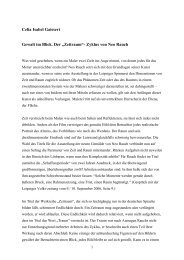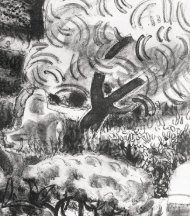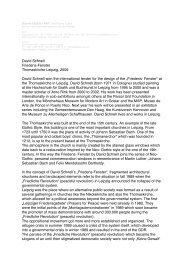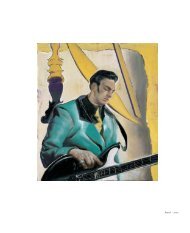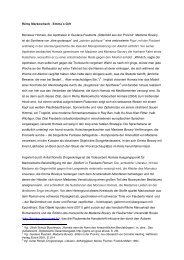Nina Fischer & Maroan el Sani Blind Spots
Nina Fischer & Maroan el Sani Blind Spots
Nina Fischer & Maroan el Sani Blind Spots
Erfolgreiche ePaper selbst erstellen
Machen Sie aus Ihren PDF Publikationen ein blätterbares Flipbook mit unserer einzigartigen Google optimierten e-Paper Software.
Jeroen Boomgaard<br />
The Rise<br />
It could be the opening shot of a Hollywood<br />
movie. At the beginning of The Rise a man<br />
is looking out over the South Axis which<br />
is under construction. Standing in front<br />
of a window with his back to us, he stares<br />
at the area which the city of Amsterdam<br />
dreams will become a new centre that will<br />
leave the old, canal ridden and congested<br />
space ultimat<strong>el</strong>y to tourists. We cannot<br />
read his gaze, but his stance is instantly<br />
reminiscent of the classic cinematic depic-<br />
tion of power and unbridled ambition.<br />
The setting aptly sums up the South Axis<br />
plans: its showy buildings by top architects<br />
such as Viñoly and Ito, and its complete<br />
accessibility by motorway, train station and<br />
airport, bring together an almost mythic<br />
concentration of will and capital in the area<br />
that is stretched out at his feet, while the<br />
two large vases that flank the window testi-<br />
fy that culture is also high on the agenda.<br />
Suddenly we are in another spot.<br />
Someone is ascending the staircase that<br />
is cut into the façade of one of the office<br />
towers. For the rest of the film we follow<br />
this man in his endless upwards trek.<br />
A new stretch to be climbed awaits him<br />
at each corner of the building. The structure<br />
stretches dizzyingly above him, and<br />
although he has already risen to a great<br />
height, he doesn’t appear to get any<br />
closer to the top. Time goes by, he spends<br />
the night on a projecting roof somewhere<br />
halfway up the building, another day<br />
passes, but he does not seem to get anywhere.<br />
From time to time he has a brief<br />
encounter with the fleeting shadow of a<br />
child, and gets involved in a struggle with<br />
someone who appears to be his twin. A<br />
motorway can be seen in the background,<br />
and now and then an aeroplane glides<br />
nois<strong>el</strong>essly past in the sky. But he is<br />
isolated in his endless journey to the top.<br />
It is not only the music that is responsible<br />
for the unmistakable sense of threat<br />
that hangs over the film. What the threat<br />
is, however, is not immediat<strong>el</strong>y clear.<br />
When one is dealing with tall buildings,<br />
endless stairs and the dizzying drops<br />
that ensue, dopp<strong>el</strong>gängers and mistaken<br />
identities, one immediat<strong>el</strong>y thinks of<br />
Hitchcock’s Vertigo. But in that film the<br />
main character’s acrophobia is an assignable<br />
cause of his traumatic experience,<br />
and his falling for the lookalike is driven<br />
by desire. However, the anxiety of this<br />
stair climber has no clear cause, it is<br />
not even clear what motivates his climb.<br />
He seems driven by an exigency without<br />
purpose, an ambition without desire. He<br />
climbs onwards in an almost perfunctory<br />
manner, and his anxiety appears to be<br />
prompted by the top rather than the abyss<br />
b<strong>el</strong>ow. He is driven on by the fear of<br />
never achieving the heights, but perhaps<br />
he is filled with anxiety over the void that<br />
awaits him there. In his exhausting trek<br />
he is the perfect example of the ideal<br />
office worker, a subservient member<br />
of the expensive-suit proletariat for whom<br />
the way to the top is the only option.<br />
Somewhere on his way he enters an<br />
office, but it is empty. The man doesn’t<br />
seem to know what he is looking for, and<br />
climbs on further. But we know now that<br />
there is nothing going on in this tower,<br />
the exterior of which radiates such dynamism<br />
and authority. We know that all this<br />
haughty ste<strong>el</strong>, glass and concrete conceals<br />
only an emptiness in its heart, and<br />
that the tower’s own upward drive also<br />
stems from a blind desire to reach the top.<br />
Thus, as in most of the films by <strong>Fischer</strong><br />
and <strong>el</strong> <strong>Sani</strong>, architecture plays a central<br />
role. However, while most of the films<br />
deal with the emptiness of buildings which<br />
were once charged with ideological or<br />
utopian significance, these office towers<br />
have not lost their content; their ideal<br />
is found exclusiv<strong>el</strong>y in their exterior. Their<br />
main asset is their outward uniqueness,<br />
and they regard their height as their greatest<br />
virtue. And just as the man no longer<br />
has any sense of why he continues to<br />
climb the stairs, the office towers of the<br />
South Axis have no idea why they are<br />
trying to storm the heavens. They press<br />
upwards out of blind ambition and compete<br />
with one another out of hubris.<br />
In what might be the final shot, the man<br />
looks over towards the tower opposite<br />
him, and there he sees his carbon copy<br />
standing in front of the window. The twin<br />
he struggled with on the stairs seems<br />
suddenly to have defeated him to the top.<br />
But what is involved here is not the theme<br />
of the dopp<strong>el</strong>gänger or the shadow, as this<br />
has undermined faith in the human subject<br />
since Romanticism; once again, it is about<br />
architecture. The uniformity which once<br />
was the hallmark of a w<strong>el</strong>l-functioning<br />
office building, the seriality which guaranteed<br />
the efficiency of mass production,<br />
has now become a bogey. To the extent<br />
that globalisation succeeds better in reducing<br />
everything to sameness, emphasis<br />
on exceptionality or specificity increasingly<br />
becomes a necessity, even if it is just<br />
to maintain a suggestion of the concentration<br />
and concretion of power. For a long<br />
time now the world-encompassing web<br />
of cash flows has no longer had booms<br />
and busts; everywhere, at the same moment,<br />
it can be present or absent in the<br />
same way. But, in striving for the top, the<br />
building benefits from acting as if it is still<br />
intent on some purpose. In doing so it<br />
offers a sense of purpose to the workers<br />
who, in their eternal trudge upwards, keep<br />
the money-flow treadmill in motion. At the<br />
moment their eyes meet, both men realise<br />
that the way to the top is also the way<br />
down. However, because the film is a<br />
loop, they are locked in an eternal struggle<br />
for the top without a chance of escape.<br />
There is more involved here than simply<br />
a feint that the threat is real. The office<br />
towers that confront one another in the<br />
South Axis stand for quality and culture.<br />
But at the moment when they reflect each<br />
other, they see the vacuum of their hollow<br />
pride. As stiff soldiers of capitalism, they<br />
lose all their lustre and heroism; only with<br />
difficulty can they carry out their commission.<br />
They are twins in the depths of their<br />
empty souls.<br />
Jeroen Boomgaard<br />
The Rise<br />
Es könnte die Anfangsszene eines Hollywoodfilms<br />
sein. Zu Beginn von The Rise<br />
(Der Aufstieg) sieht ein Mann aus dem<br />
Fenster und inspiziert die im Bau befindliche<br />
Südachse. Er steht mit dem Rücken<br />
zu uns und starrt auf ein Gebiet, in dem<br />
sich die Stadt Amsterdam ein neues Zentrum<br />
erträumt, das den alten, kanaldurchzogenen<br />
und übervölkerten Bereich der<br />
Stadt endgültig den Touristen überlässt.<br />
Seine Augen können wir nicht sehen, aber<br />
seine Körperhaltung erinnert sofort an<br />
die klassische filmische Darst<strong>el</strong>lung von<br />
Macht und grenzenlosem Ehrgeiz. Die<br />
Szene resümiert treffend die Südachsenpläne:<br />
Protzige Gebäude von Toparchitekten<br />
wie Viñoly und Ito und ihre totale<br />
Verkehrsanbindung an Autobahn, Bahnhof<br />
und Flughafen erzeugen in diesem<br />
Gebiet eine fast mythische Konzentration<br />
von Willenskraft und Kapital, die sich<br />
zu Füßen des Protagonisten erstreckt,<br />
während die zwei großen Vasen, die das<br />
Fenster flankieren, b<strong>el</strong>egen, dass auch<br />
Kultur weit oben auf der Tagesordnung<br />
steht.<br />
Wir erleben einen plötzlichen Ortswechs<strong>el</strong>.<br />
Jemand erklimmt eine Treppe,<br />
die in die Außenhülle eines Büroturms<br />
eing<strong>el</strong>assen ist. Den Rest des Films folgen<br />
wir diesem Mann auf seinem endlosen<br />
Weg. An jeder Ecke des Gebäudes erwartet<br />
ihn wieder ein neuer Treppenabschnitt.<br />
Schwind<strong>el</strong>erregend erhebt sich das Bauwerk<br />
über ihm, und obwohl er bereits eine<br />
große Höhe erreicht hat, scheint er sich<br />
der Spitze in keiner Weise zu nähern. Die<br />
Zeit vergeht, er verbringt die Nacht auf<br />
einem Dachvorsprung irgendwo auf halber<br />
Höhe, ein weiterer Tag verstreicht, aber<br />
der Mann scheint nicht voranzukommen.<br />
Ab und zu begegnet er kurz dem fliehenden<br />
Schatten eines Kindes oder wird in<br />
einen Kampf mit einer Gestalt verwick<strong>el</strong>t,<br />
die sein Zwilling zu sein scheint. Im Hintergrund<br />
ist eine Autobahn zu sehen, und<br />
g<strong>el</strong>egentlich schwebt am Himm<strong>el</strong> lautlos<br />
ein Flugzeug vorbei. Aber auf seinem<br />
endlosen Weg zur Spitze ist der Mann<br />
völlig von der W<strong>el</strong>t abgeschnitten.<br />
Nicht nur die Musik ist für das deutliche<br />
Gefühl der Bedrohung verantwortlich, das<br />
den Film durchzieht. Allerdings ist nicht<br />
gleich klar, worin die Bedrohung besteht.<br />
Hohe Gebäude, endlose Treppen und<br />
damit verbundene schwind<strong>el</strong>erregende<br />
Höhen, Dopp<strong>el</strong>gänger und Verwechslungen<br />
lassen einen sofort an Hitchcocks<br />
Vertigo – Aus dem Reich der Toten denken.<br />
Aber dort hat die Höhenangst des<br />
Protagonisten ihre bestimmbare Ursache<br />
in einem traumatischen Erlebnis, während<br />
seine Gefühle für die Dopp<strong>el</strong>gängerin<br />
von sinnlichem Verlangen bestimmt sind.<br />
Für die Angst des Treppensteigers gibt<br />
es hingegen keine nachvollziehbare Ursache,<br />
und auch der Grund, warum er nach<br />
oben strebt, bleibt unklar. Er scheint von<br />
einem zi<strong>el</strong>losen Drang, von unmotiviertem<br />
Ehrgeiz getrieben zu sein. Fast nachlässig<br />
wirkt sein Klettern, und seine Angst<br />
scheint eher von dem vor ihm liegenden<br />
Zi<strong>el</strong> ausg<strong>el</strong>öst zu sein als vom unter ihm<br />
klaffenden Abgrund. Die Furcht, den Aufstieg<br />
nicht zu bewältigen, treibt ihn voran,<br />
aber vi<strong>el</strong>leicht erfüllt ihn auch Angst vor<br />
der Leere, die ihn oben erwartet. So, wie<br />
er sich abplagt, liefert er das Idealbeispi<strong>el</strong><br />
für den perfekten Büroangest<strong>el</strong>lten; er<br />
ist ein willfähriger Angehöriger des Anzugproletariats,<br />
für den der Aufstieg an die<br />
Spitze die einzig mögliche Option darst<strong>el</strong>lt.<br />
Irgendwo unterwegs betritt unser Pro-<br />
tagonist ein Büro, das jedoch leer steht.<br />
Er scheint nicht zu wissen, wonach er<br />
sucht, und klettert weiter. Wir jedoch wissen<br />
jetzt, dass in diesem Turm, dessen<br />
Äußeres Dynamik und Autorität ausstrahlt,<br />
nichts passiert. Wir wissen, dass all der<br />
stolze Stahl, das Glas und der Beton<br />
nur die Leere in seinem Herzen verbergen<br />
und dass das Aufstreben des Turms<br />
s<strong>el</strong>bst gen Himm<strong>el</strong> auch von einem blinden<br />
Verlangen herrührt, die Spitze zu erreichen.<br />
Somit ist Architektur, wie in den<br />
meisten Filmen von <strong>Fischer</strong> und <strong>el</strong> <strong>Sani</strong>,<br />
auch hier von zentraler Bedeutung. Aber<br />
während sie sich meist mit der Leere von<br />
Gebäuden befassen, die einst mit ideologischer<br />
oder utopischer Bedeutung aufg<strong>el</strong>aden<br />
waren, haben diese Bürotürme<br />
ihren Inhalt nicht verloren: Das Ideal findet<br />
sich vi<strong>el</strong>mehr ausschließlich in ihrem Äußeren.<br />
Ihren größten Vorzug sehen sie<br />
in ihrer äußeren Einzigartigkeit und ihrer<br />
Höhe. Und so wie der Mann keine Vorst<strong>el</strong>lung<br />
mehr davon hat, warum er den Stufen<br />
weiter nach oben folgt, haben auch die<br />
Bürotürme der Südachse keine Vorst<strong>el</strong>lung,<br />
warum sie die Himm<strong>el</strong> zu stürmen<br />
versuchen. Aus blindem Eifer streben sie<br />
nach oben, konkurrieren sie hochmütig<br />
miteinander.<br />
In einer Szene, die die Schlussein-<br />
st<strong>el</strong>lung sein könnte, schaut der Mann<br />
auf der Treppe zum Turm gegenüber<br />
und sieht dort sein Abziehbild am Fenster<br />
stehen. Der Zwilling, mit dem er auf der<br />
Treppe gekämpft hatte, scheint den Weg<br />
nach oben plötzlich als Erster geschafft<br />
zu haben. Aber hier geht es nicht um<br />
das Dopp<strong>el</strong>gänger- oder Schattenthema,<br />
das seit der Romantik den Glauben an<br />
das menschliche Individuum erschüttert;<br />
einmal mehr geht es um Architektur. Die<br />
Einheitlichkeit, die einst für ein gut funktionierendes<br />
Bürogebäude stand, die<br />
Serienherst<strong>el</strong>lung, die die Effizienz der<br />
Massenproduktion gewährleistete, ist nunmehr<br />
zum Schreckgespenst geworden.<br />
In dem Maße, in dem die Globalisierung<br />
umso erfolgreicher funktioniert, wenn sie<br />
alles auf den kleinsten gemeinsamen<br />
Nenner reduziert, wird es zunehmend zur<br />
Notwendigkeit, das Augenmerk auf das<br />
Außergewöhnliche und Besondere zu richten,<br />
und sei es nur, um die Idee der Konzentration<br />
und Verschm<strong>el</strong>zung von Macht<br />
aufrechtzuerhalten. Das w<strong>el</strong>tumspannende<br />
Netz der G<strong>el</strong>dströme erlebt keine<br />
Höhen und Tiefen mehr; es kann überall<br />
gleichzeitig und gleichermaßen vorhanden<br />
oder abwesend sein. Aber es profitiert<br />
davon, so zu tun, als sei es zweckgerichtet<br />
und strebe an die Spitze. Dadurch gibt<br />
es Arbeitern und Angest<strong>el</strong>lten einen Sinn<br />
im Leben, die mit ihrem ewigen Marsch<br />
nach oben die Tretmühle und damit den<br />
G<strong>el</strong>dstrom in Bewegung halten. In dem<br />
Moment, wenn sich ihre Blicke begegnen,<br />
realisieren die beiden Männer, dass der<br />
Weg an die Spitze gleichzeitig auch nach<br />
unten führt. Aber weil der Film eine Schleife<br />
ist, sind sie im ewigen Kampf um den<br />
Spitzenplatz gefangen, ohne auch nur<br />
die geringste Chance zur Flucht zu haben.<br />
Es geht hier um mehr als um bloße<br />
Simulation – es geht um eine reale Gefahr.<br />
Die sich gegenüberstehenden Bürotürme<br />
auf der Südachse symbolisieren Qualität<br />
und Kultur. Aber wenn sie sich ineinander<br />
spieg<strong>el</strong>n, blicken sie in die Leere ihres<br />
hohlen Stolzes. Als hartnäckige Soldaten<br />
des Kapitalismus verlieren sie all ihren<br />
Glanz und ihre H<strong>el</strong>denhaftigkeit; nur unter<br />
Schwierigkeiten können sie ihren Auftrag<br />
erfüllen. Tief in ihren leeren Se<strong>el</strong>en<br />
gleichen sie sich wie ein Ei dem anderen.




